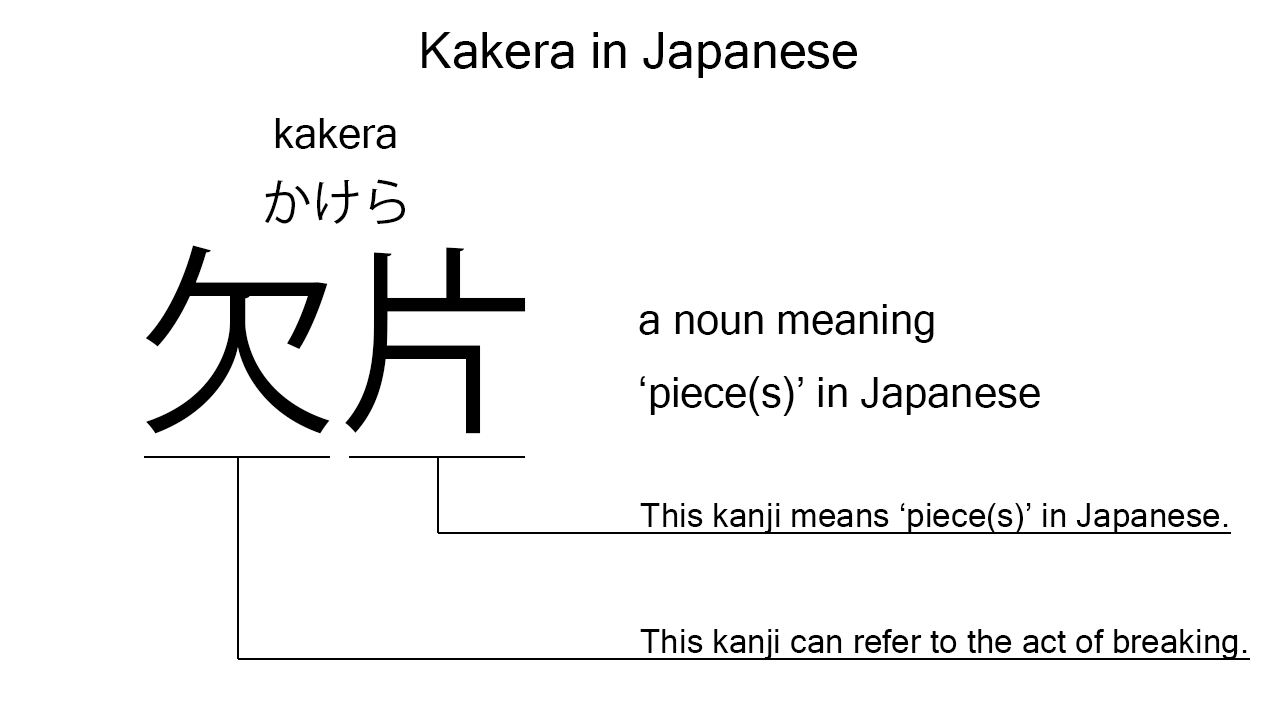What does “kakera” mean in Japanese?
Native speakers say “kakera” often to mean ‘piece’ in Japanese. Perhaps, some Japanese learners know this word as it is sometimes used in Japanese movies, songs, novels, manga, anime, and the like. In this blog post, however, I will explain this word in detail based on its kanji expression. And also, I will explain how to use it through example sentences. My explanations would help Japanese learners understand “kakera” more clearly. Then, let’s get started!
Contents
Definition and meanings of “kakera”
Let me start with the definition and meanings of “kakera”.
- kakera – 欠片 (かけら) : a noun meaning ‘piece’, ‘fragment’, or ‘broken piece’ in Japanese. This can also work as plural. Learn more about Japanese plural.
The definition and meanings are simple and clear. The meanings seem to be based on very similar concepts. To understand this noun more clearly, however, let me explain its kanji characters in detail, one by one.
Kakera in kanji
The kanji expression of “kakera” consists of the following two kanji characters:
- 欠 : a kanji character often used to refer to the act of lacking, missing, or breaking.
- 片 : a kanji character used to mean ‘one of a pair’, ‘piece of something’, or such in Japanese.
These two kanji characters tell us that the formed noun literally means a ‘broken piece’ in Japanese. This literal interpretation is more or less in line with the actual meanings.

When we meet new kanji expressions, we should check their kanji characters in detail to understand their meanings clearly and deeply. In many cases, kanji characters tell us a lot about the meanings of the expressions they form. Actually, here, we could get the better understanding of “kakera” through the detailed kanji check above.
So far, I’ve explained the definition and meanings of “kakera” together with its kanji characters. Then, let me explain how to use it through the example sentences below.
Example #1: how to say “piece” in Japanese
kore wa kanojo no kioku no kakera – これは彼女の記憶の欠片 (これはかのじょのきおくのかけら)
This is a piece of her memories.
Below are the new words used in the example sentence.
- kore – これ : a pronoun used to refer to something close to the speaker. In the example, this is used to say “this” in Japanese.
- wa – は : a binding particle working as a case marker or topic marker. In the example, this works after “kore” to make the subject in the sentence.
- kanojo – 彼女 (かのじょ) : a pronoun meaning ‘she’ in Japanese.
- no – の : a case particle used after a noun or pronoun to make its possessive case. In the example, this is used after “kanojo” to make its possessive case, “kanojo no”, which means ‘her’ in Japanese.
- kioku – 記憶 (きおく) : a noun meaning ‘memory’ in Japanese. This can also work as plural.
- no – の : a case particle joining two nouns or noun equivalent words. Normally, the first one can work as a modifier to describe the second. In the example, this works to join “kanojo no kioku” and “kakera”. The formed phrase literally means a ‘piece of her memories’ in Japanese. Word orders in Japanese and English are different, but the role of this case particle is similar to that of the English preposition, “of”.
This is a typical usage of “kakera”. In this example, it works as a part of the noun phrase, “kanojo no kioku no kakera”, which means ‘a piece of her memories’ in Japanese.
Example #2: another usage of “kakera”
boku wa koko de kakera wo atsume te iru – 僕はここで欠片を集めている (ぼくはここでかけらをあつめている)
I’m collecting pieces here.
Below are the new words used in the example sentence.
- boku – 僕 (ぼく) : a pronoun meaning ‘I’ in Japanese. This is used mainly by boys and young males.
- koko – ここ : a pronoun used to refer to a place close to the speaker.
- de – で : a case particle used to say where someone does something. In the example, this is used after “koko” to say where the speaker is collecting the pieces.
- wo – を : a case particle used to make the object word in a sentence. In the example, this is used after “kakera” to make the object in the sentence.
- atsume – 集め (あつめ) : one conjugation of the verb, “atsumeru”, which means ‘to collect’ in Japanese. In the example, it has been conjugated for the better connection with its following word.
- te – て : a conjunctive particle used after a verb, adjective, or auxiliary verb to make its te form. In the example, this is used after “atsume” to make its te form, “atsume te”. Verbs need to be changed to their te forms to be connected with “iru”.
- iru – いる : an auxiliary verb used to express the continuity of the action described by its preceding verb. In the example, this is used after “atsume te” to express the continuity of its action.
This is another typical usage of “kakera”. In this example, it works together with the case particle, “wo”, to become the object in the sentence. Anyway, when we want to refer to a piece, fragment, or broken piece in Japanese, “kakera” is a good option.
Summary
In this blog post, I’ve explained the definition and meanings of “kakera” in detail based on its kanji expression. And also, I’ve explained how to use it through the example sentences. Let me summarize them as follows.
- kakera – 欠片 (かけら) : a noun meaning ‘piece’, ‘fragment’, or ‘broken piece’ in Japanese. This can also work as plural. These two kanji characters literally mean a ‘broken piece’ in Japanese. This literal interpretation is more or less in line with the actual meanings.
Hope my explanations are understandable and helpful for Japanese learners.